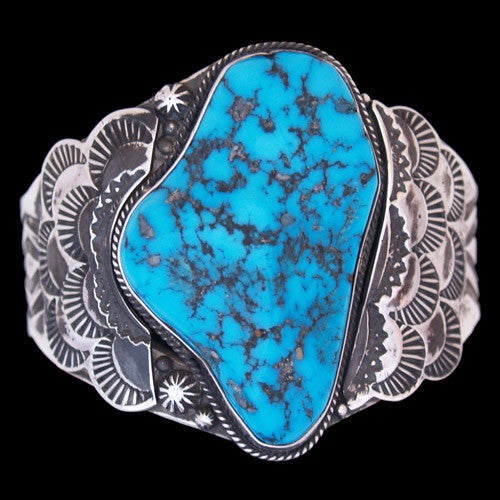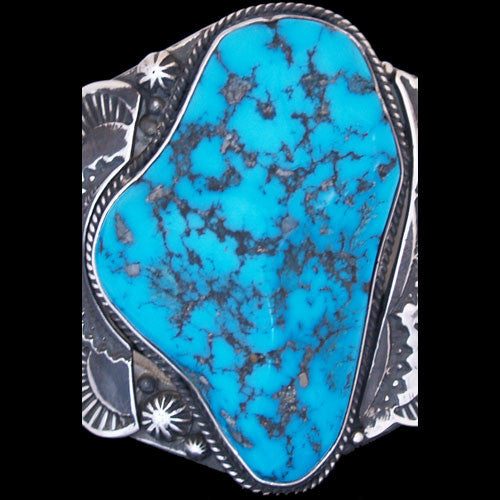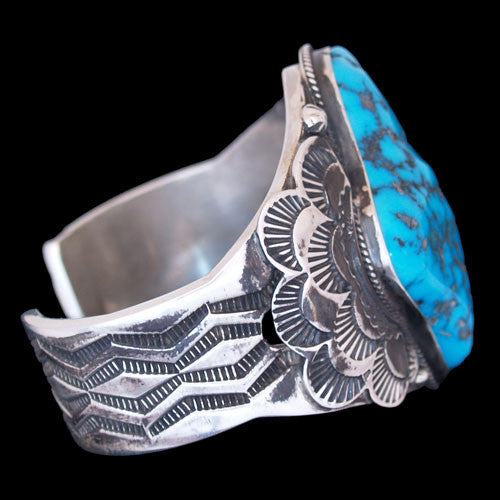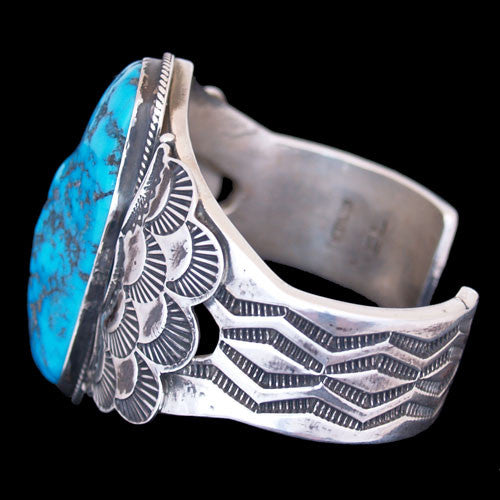




Navajo Castle Dome Turquoise Bracelet - Eugune Livingston (#128)
$3,200.00
Artist: Eugune Livingston
ATC
Navajo Jewelry
Castle Dome Turquoise Bracelet
Size: 6 1/2
In his latest work, Eugene Livingston has revived a 1940s jewelry design, added his own twist of creativity and crafted a very nice wrist cuff. Eugene starts with sterling silver shot, heats it until molten and pours it into a bar. He then puts the bar through a heavy duty roller and mills it to the desired thickness. Using this process he makes his own silver sheet and wire in order to create his unique jewelry pieces. The solidity and strength of Eugene's jewelry allows it to wear better and last longer. This bracelet is set with a high grade, natural cabochon of Castle Dome turquoise from Globe, Arizona.
We offer a 100% satisfaction guarantee on every purchase.
Castle Dome Turquoise
Castle Dome turquoise is derived from the Globe-Miami mining district, Gila County, Arizona, five miles west of Miami. The Castle Dome open-pit copper mine, rests on the south slope of Porphyry Mountain.
Castle Dome Turquoise, CuO·3Al2O3·P2O5·H2O.--is fairly widespread throughout the chalcocite zone and in the leached capping. A hard variety of gem quality occurs in small veinlets up to one-quarter inch thick and also in concretion-like masses up to one-half inch thick and several inches across. Its color ranges from sky-blue to bluish-green, the blue variety predominating. It is generally associated with clay minerals and sericite which form selvages on the veins and masses and are commonly included in the turquoise. Seen under the microscope; it it is a microcrystalline aggregate having a mean index of refraction of 1.62.
A few specimens of a light-green, iron-bearing copper aluminum phosphate were found occurring in the same manner as the hard blue turquoise. It is a microcrystalline aggregate whose mean index of refraction is 1.67. Charles Milton of the Geological Survey identified the mineral as a ferrian turquoise. He reports as follows:
Employees of the mine have been permitted to dig turquoise on days when they were not on duty, and an amazingly large quantity of the mineral has been purchased by dealers in Globe and Miami. Unfortunately no record is available as to the amount of turquoise produced, but undoubtedly the Castle Dome mine is one of the most important sources of gem turquoise at the present time.
Turquoise is generally conceded to be a supergene mineral, formed by the action of ground-water solutions, carrying copper and phosphate ions, on kaolin and possibly sericite. Various writers describe all stages in the alteration from copper-stained kaolin to hard blue turquoise; but it is not usually clear from the published descriptions whether the mineral is kaolinite or some other clay. Kaolinite is not a common mineral in the Castle Dome deposit, and its association with turquoise has not been noted; however, turquoise is commonly associated with beidellite, halloysite, and sericite. No evidence has yet been found suggesting that it forms from clay. The hard blue turquoise grades into the soft, white clay-like variety; but the index of refraction of all of it is near 1.62, which is much higher than that of any of the clays present. None of the material could be construed as being transitional between turquoise and the associated clay.
Although turquoise is most abundant in the upper part of the secondary sulfide zone, it is commonly found in deep fractures where chalcopyrite is only slightly replaced by chalcocite or not at all. If turquoise was formed by supergene solutions, the phosphate ion would have to be derived from either wavellite or apatite which are the only earlier phosphate minerals. Wavellite is apparently dissolved by supergene solutions, but much turquoise occurs in parts of the mine where no wavellite has been recognized. In the Castle-an-Dinas mine in Cornwall,15 wavellite spheres are commonly covered by minute botryoidal aggregates of bright-green turquoise, but no such association has been seen in the Castle Dome deposit. Most writers look to apatite as the probable source of phosphate ion even though admitting in some cases that the country rock contains very little apatite.
American Mineralogist. Volume 63, pages 574-582, PHOSPHATE MINERALS IN THE CASTLE DOME COPPER DEPOSIT, ARIZONA., N.P. Peterson, Abstract
About the artist:

Eugene Livingston - Navajo Jewelry
Eugene is one of those rare artists who has mastered not just one or two methods, but a myriad of jewelry techniques. As a young man, he trained under other talented silversmiths After many decades of steady work, Eugene is skilled at metal fabrication, casting, making his own silver ingots, and most importantly for his work, the ability to cut stones. In his work below, you will see beautiful cut teardrop and pyramid cut Sleeping Beauty turquoise and coral. His two newest pieces with Carico Lake turquoise demonstrate his mastery of silver stamp work.
Related legends:
Silversmith Work
When and how the Navajo acquired the art of working metals is unknown but there are reasons for supposing that it was introduced among them, or at least more developed and improved upon by them, since the time they have occupied their present country?
